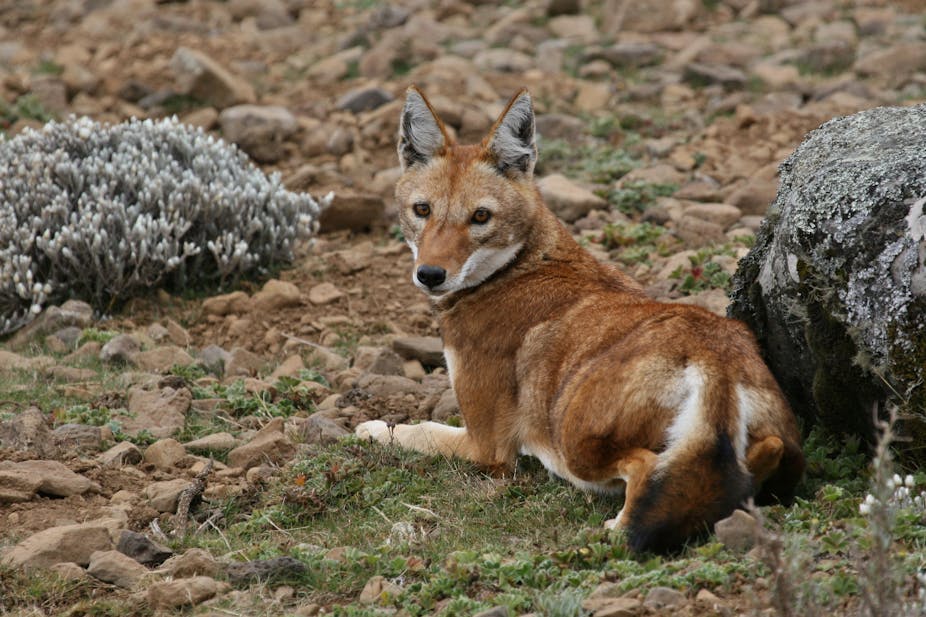Humans have decimated the world’s mammals over the last several thousand years and continue to do so today. Ghosts of mammoths, bison, horses, and saber-toothed cats haunt the Americas and Eurasia, casualties of expanding Upper Paleolithic populations over the last approximately 100,000 years. Oceanic islands, such as the Hawaiian Islands, were once remote sanctuaries of biodiversity but have been reduced to impoverished faunas overrun with invasive species transported there by ships and planes.
Africa has largely been spared from this destruction, but even on this continent all is not well. The bluebuck, an antelope native to southern Africa, was hunted to extinction around 1800 AD. This made it the continent’s first large mammal to disappear in historical times.
Other species in Africa seem destined for a similar fate – and while the decline of elephants, gorillas and rhinos garners weekly headlines in the press, many lesser-known species like the Ethiopian wolf and hirola are at an even greater risk. These already fragmented and fragile populations will compete for resources with a human population that the United Nations says is going to quadruple by 2100.
Ominously looming over the direct conflict for space between wildlife and an expanding human population is climate change. In eastern Africa, droughts have increased in frequency over the last several decades. This has happened in parallel with human-induced warming of the Indian Ocean, which controls the region’s rainfall.
In response to these developments, scientists in Africa and across the world have initiated a great deal of research into mitigating the effects of climate change on wildlife. This tide of research has led us to revisit some fundamental questions: how are mammal species’ distributions related to climate? How does climate sensitivity vary across different mammal groups?
Almost every study addressing these questions begins with the same assumption. That is, mammal distributions and communities today are in sync with modern climate and will track future climate change in real time. The validity of this assumption is critical to forecasting species’ responses to future climate change. My colleagues and I were interested in testing it.
Human impact
The devastating 2009 drought in Amboseli, Kenya, provides a macabre example of how changing climate and human encroachment into wild lands may play out over the next century.
In Amboseli, the seasonal rains failed and the park’s herbivores sought refuge in the lowland swamps and woodlands that had buffered them from scarce times in the past. Human development within and around the perimeters of the ecosystem, however, had destroyed these safe havens and cut off any exit route. Surrounded by roads and farms, thousands of elephants, wildebeest and zebras had nowhere to flee. Marooned on their drying island, these animals starved to death in the shadow of Kilimanjaro.

Sadly, while the magnitude of climate change will increase over the next century, the shrinking and isolation of wild lands is unlikely to end. As I write this, the Tanzanian government has once again opened bids for a paved highway through the heart of the Serengeti, a UNESCO World Heritage site.
The past informs the future
In our study, we wanted to test the assumption that mammal distributions and communities today are in sync with modern climate and will track future climate change in real time. So we compiled a large dataset of mammal communities in Africa today. We quantified their ecological structure, and asked whether this structure was more closely tied to present climate or to climate of the deep past, paleoclimate.
We looked to paleoclimate because present-day mammal communities are the ultimate products of species interacting with changes in their environments across space and time over decades, centuries, and millennia. It is possible that rates of environmental change may outpace species’ abilities to respond. Such a finding would cast doubt on the assumption that species today are in sync with present-day climate.
Our results were clear and startling. The structure of mammal communities today is largely the product of climates thousands of years ago: the cool and arid Last Glacial Maximum (around 22,000 years ago) and warm and wet mid-Holocene (around 6,000 years ago).
There are two potential explanations for this pattern. First, mammal species have failed to track their preferred climates over the last several thousand years and there is a significant time lag between climate change and species’ responses. This would certainly be a disheartening result considering natural rates of climate change are dwarfed by those of man-made climate change.
A more optimistic view is that mammals are flexible enough to have persisted through changing climates over thousands of years. This explains why community structure is more closely tied to paleoclimate, and therefore may be able to cope with future changes. Even under this scenario, however, there is cause for alarm. If species have coped with gradually changing climates, we still don’t know how they will respond to rapidly changing ones over the next century.
Looking ahead
Going forward I believe that a greater integration of paleoclimate data into ecological studies will provide a more comprehensive understanding of how species respond to climate change. Several studies have already begun to investigate how ancient human impacts alter ecological patterns today, including species associations and geographic relationships. Extending this work to paleoclimate will bear both theoretical and applied fruit.

